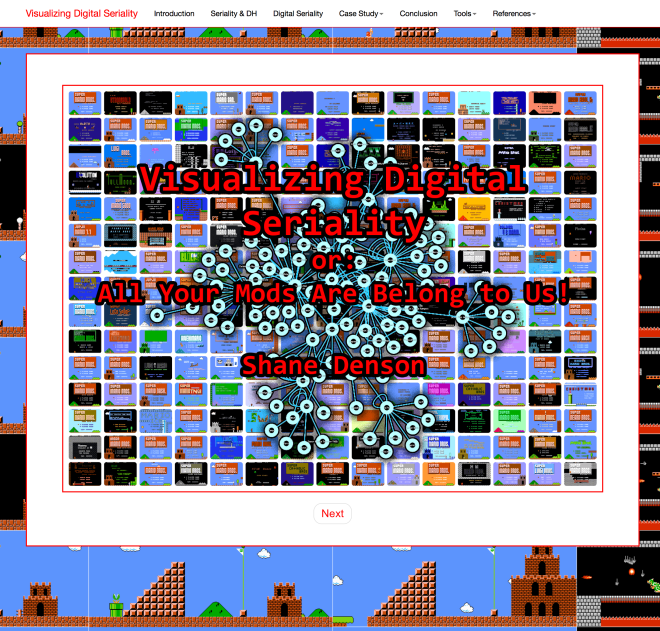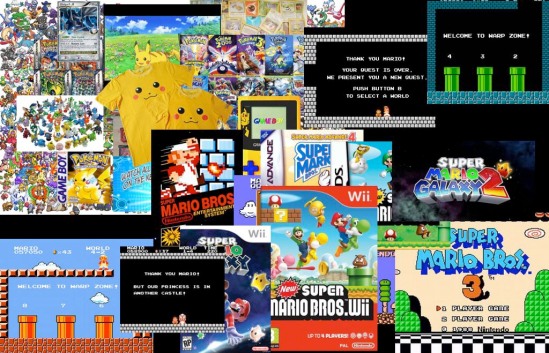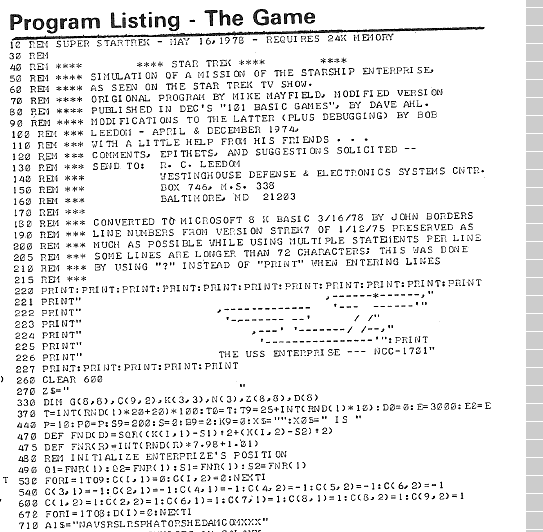I am excited to see my interactive piece, “Visualizing Digital Seriality, or: All Your Mods Are Belong to Us,” out now in the latest issue of Kairos: A Journal of Rhetoric, Technology, and Pedagogy. This is by far the most technically demanding piece of scholarship I have ever produced, and it underwent what is possibly the most rigorous peer-review process to which any of my published articles has ever been subject. If you’re interested in data visualization, distant reading techniques, network graphing, critical code studies, game studies, modding scenes, or Super Mario Bros. (and who doesn’t like Super Mario Bros.?), check it out!
Tag: ludic serialities
Seriality
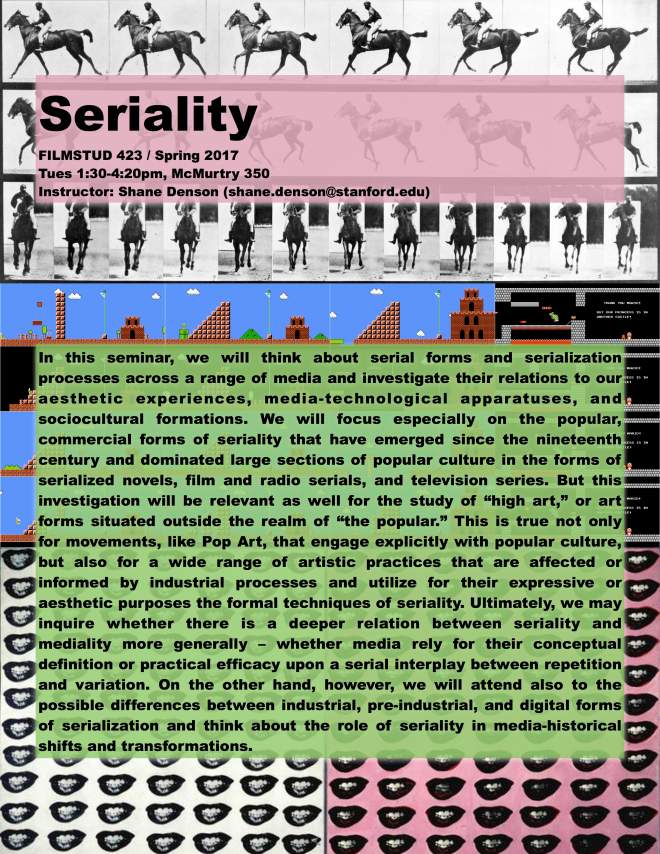
Flyer for my “Seriality” course, Spring 2017 at Stanford. Complete syllabus here.
Seriality Seriality Seriality
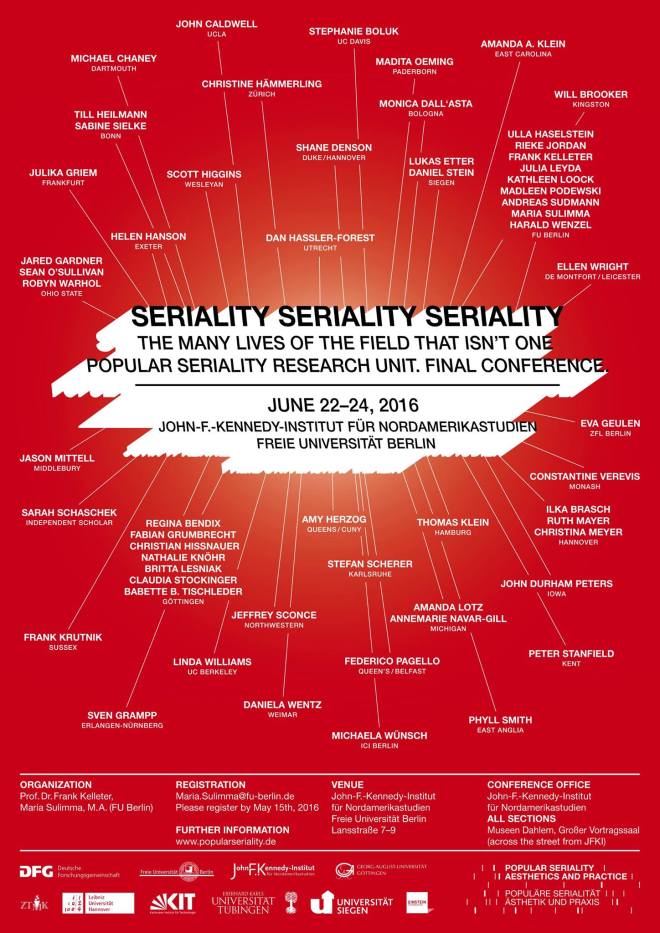
Poster for the upcoming conference “Seriality Seriality Seriality: The Many Lives of the Field that Isn’t One” (final conference of the Popular Seriality Research Unit), taking place June 22-24, 2016 at the Freie Universität Berlin!
More info at the conference website.
Ludic Serialities @ CUNY
On April 23-24, 2015, I will be participating in the conference “Thinking Serially: Repetition, Continuation, Adaptation,” hosted by the Department of Comparative Literature at the Graduate Center, CUNY. You can find the full program here, and here is the abstract for the talk I’ll be giving:
Ludic Serialities: Levels of Serialization in Digital Games and Gaming Communities
Shane Denson (Duke University, Program in Literature)
In this paper, I outline several layers of seriality that are operative in and around the medium of digital games. Some of these resemble pre-digital forms of popular seriality, as they have been articulated in commercial entertainments since the nineteenth century; others would seem to be unique to digital formats and the ludic forms of interactivity they facilitate. Thus, the “inter-ludic” seriality of sequels, remakes, and spinoffs that constitute popular game franchises are recognizable in terms of the (predominantly narrative) seriality that has characterized serialized novels, films serials, television series, cinematic remakes and blockbuster trilogies. But these franchises also give rise to “para-ludic” forms of seriality that are more squarely at home in the digital age: games form parts of larger transmedia franchises, which depend in many ways on the infrastructure of the Internet to support exchanges among fans. On the other hand, games also articulate low-level “intra-ludic” serialities through the patterns of repetition and variation that characterize game “levels” and game engines. These serialized patterns are often non-narrative in nature, manifesting themselves in the embodied rhythms instantiated as players interface with games; they therefore challenge the traction of pre-digital conceptions and point to what would appear an unprecedented form of “infra-ludic” serialization at the level of code and hardware. Interestingly, however, such ultra-low-level serialities remain imbricated with the high-level seriality of socio-cultural exchange; levels of code and community cross, for example, in highly serialized modding communities.
This presentation takes a comparative approach in order to identify historical, cultural, and medial specificities and overlaps between digital and pre-digital forms of seriality. Besides outlining the levels of seriality described above, I will also look at methodological challenges for studying these new forms, as well as several approaches (including both close and “distant” forms of reading) designed to meet these challenges.
Bibliography:
Boluk, Stephanie, and Patrick LeMieux. “Hundred Thousand Billion Fingers: Seriality and Critical Game Practices.” Leonardo Electronic Almanac 17.2 (2012): 10-31. http://www.leoalmanac.org/wp-content/uploads/2012/04/LEAVol17No2- BolukLemieux.pdf
Denson, Shane, and Andreas Jahn-Sudmann. “Digital Seriality: On the Serial Aesthetics and Practice of Digital Games.” Eludamos: Journal for Computer Game Culture 7.1 (2013): 1-32. http://www.eludamos.org/index.php/eludamos/article/view/vol7no1-1/7-1-1- pdf
Denson, Shane, and Andreas Jahn-Sudmann, eds. Digital Seriality. Special issue. Eludamos: Journal for Computer Game Culture 8.1 (2014). http://www.eludamos.org/index.php/eludamos/issue/view/vol8no1
Kelleter, Frank, ed. Populäre Serialität: Narration – Evolution – Distinktion. Zum seriellen Erzählen seit dem 19. Jahrhundert. Bielefeld: Transcript, 2012.
Mario Modding Madness
Livestream: Visualizing Digital Seriality
According to the Duke Visualization Friday Forum website, my talk this Friday — “Visualizing Digital Seriality: Correlating Code and Community in the Super Mario Modding Scene” — will be streamed live: here.
The talk will take place at 12:00 Eastern time, Jan. 30, 2015.
DAAD Postdoctoral Fellowship at Duke University


At long last, I am excited to announce that my application for a 2-year postdoctoral fellowship at Duke University has been approved for funding through the DAAD (German Academic Exchange Service). At Duke, I will be working closely with Mark B. N. Hansen and other scholars of media and culture to develop a media-archaeological perspective on serialization processes in video games and digital media culture more generally. The fellowship, which runs from August 2014 to July 2016, will allow me to conduct archival research in the US that will supplement and expand my work in the project “Digital Seriality” that I co-direct with Andreas Jahn-Sudmann in the context of the DFG Research Unit “Popular Seriality — Aesthetics and Practice.” Needless to say, I am very excited about this, and I will continue to post updates here! More soon…
CFP: Digital Seriality — Special Issue of Eludamos: Journal for Computer Game Culture
I am pleased to announce that my colleague Andreas Jahn-Sudmann and I will be co-editing a special issue of Eludamos: Journal for Computer Game Culture on the topic of “Digital Seriality.” Here, you’ll find the call for papers (alternatively, you can download a PDF version here). Please circulate widely!
Call for Papers: Digital Seriality
Special Issue of Eludamos: Journal for Computer Game Culture (2014)
Edited by Shane Denson & Andreas Jahn-SudmannAccording to German media theorist Jens Schröter, the analog/digital divide is the “key media-historical and media-theoretical distinction of the second half of the twentieth century” (Schröter 2004:9, our translation). And while this assessment is widely accepted as a relatively uncontroversial account of the most significant media transformation in recent history, the task of evaluating the distinction’s inherent epistemological problems is all the more fraught with difficulty (see Hagen 2002, Pias 2003, Schröter 2004). Be that as it may, since the 1990s at the latest, virtually any attempt to address the cultural and material specificity of contemporary media culture has inevitably entailed some sort of (implicit or explicit) evaluation of this key distinction’s historical significance, thus giving rise to characterizations of the analog/digital divide as caesura, upheaval, or even revolution (Glaubitz et al. 2011). Seen through the lens of such theoretical histories, the technical and especially visual media that shaped the nineteenth and twentieth centuries (photography, film, television) typically appear today as the objects of contemporary digitization processes, i.e. as visible manifestations (or remnants) of a historical transition from an analog (or industrial) to a digital era (Freyermuth and Gotto 2013). Conversely, despite its analog pre-history today’s digital computer has primarily been addressed as the medium of such digitization processes – or, in another famous account, as the end point of media history itself (Kittler 1986).
The case of digital games (as a software medium) is similar to that of the computer as a hardware medium: although the differences and similarities between digital games and older media were widely discussed in the context of the so-called narratology-versus-ludology debate (Eskelinen 2001; Juul 2001; Murray 1997, 2004; Ryan 2006), only marginal attention was paid in these debates to the media-historical significance of the analog/digital distinction itself. Moreover, many game scholars have tended to ontologize the computer game to a certain extent and to treat it as a central form or expression of digital culture, rather than tracing its complex historical emergence and its role in brokering the transition from analog to digital (significant exceptions like Pias 2002 notwithstanding). Other media-historiographical approaches, like Bolter and Grusin’s concept of remediation (1999), allow us to situate the digital game within a more capacious history of popular-technical media, but such accounts relate primarily to the representational rather than the operative level of the game, so that the digital game’s “ergodic” form (Aarseth 1999) remains largely unconsidered.
Against this background, we would like to suggest an alternative angle from which to situate and theorize the digital game as part of a larger media history (and a broader media ecology), an approach that attends to both the representational level of visible surfaces/interfaces and the operative level of code and algorithmic form: Our suggestion is to look at forms and processes of seriality/serialization as they manifest themselves in digital games and gaming cultures, and to focus on these phenomena as a means to understand both the continuities and the discontinuities that mark the transition from analog to digital media forms and our ludic engagements with them. Ultimately, we propose, the computer game simultaneously occupies a place in a long history of popular seriality (which stretches from pre-digital serial literature, film, radio, and television, to contemporary transmedia franchises) while it also instantiates novel forms of a specifically digital type of seriality (cf. Denson and Jahn-Sudmann 2013). By grappling with the formal commensurabilities and differences that characterize digital games’ relations to pre-digital (and non-ludic) forms of medial seriality, we therefore hope to contribute also to a more nuanced account of the historical process (rather than event) of the analog/digital divide’s emergence.
Overall, seriality is a central and multifaceted but largely neglected dimension of popular computer and video games. Seriality is a factor not only in explicitly marked game series (with their sequels, prequels, remakes, and other types of continuation), but also within games themselves (e.g. in their formal-structural constitution as an iterative series of levels, worlds, or missions). Serial forms of variation and repetition also appear in the transmedial relations between games and other media (e.g. expansive serializations of narrative worlds across the media of comics, film, television, and games, etc.). Additionally, we can grasp the relevance of games as a paradigm example of digital seriality when we think of the ways in which the technical conditions of the digital challenge the temporal procedures and developmental logics of the analog era, e.g. because once successively appearing series installments are increasingly available for immediate, repeated, and non-linear forms of consumption. And while this media logic of the database (cf. Manovich 2001: 218) can be seen to transform all serial media forms in our current age of digitization and media convergence, a careful study of the interplay between real-time interaction and serialization in digital games promises to shed light on the larger media-aesthetic questions of the transition to a digital media environment. Finally, digital games are not only symptoms and expressions of this transition, but also agents in the larger networks through which it has been navigated and negotiated; serial forms, which inherently track the processes of temporal and historical change as they unfold over time, have been central to this media-cultural undertaking (for similar perspectives on seriality in a variety of media, cf. Beil et al. 2013, Denson and Mayer 2012, Jahn-Sudmann and Kelleter 2012, Kelleter 2012, Mayer 2013).
To better understand the cultural forms and affective dimensions of what we have called digital games’ serial interfacings and the collective serializations of digital gaming cultures (cf. Denson and Jahn-Sudmann 2013), and in order to make sense of the historical and formal relations of seriality to the emergence and negotiation of the analog/digital divide, we seek contributions for a special issue of Eludamos: Journal of Computer Game Culture on all aspects of game-related seriality from a wide variety of perspectives, including media-philosophical, media-archeological, and cultural-theoretical approaches, among others. We are especially interested in papers that address the relations between seriality, temporality, and digitality in their formal and affective dimensions.
Possible topics include, but are not limited to:
- Seriality as a conceptual framework for studying digital games
- Methodologies and theoretical frameworks for studying digital seriality
- The (im)materiality of digital seriality
- Digital serialities beyond games
- The production culture of digital seriality
- Intra-ludic seriality: add-ons, levels, game engines, etc.
- Inter-ludic seriality: sequels, prequels, remakes
- Para-ludic seriality: serialities across media boundaries
- Digital games and the limits of seriality
******************************************************************************
Paper proposals (comprising a 350-500 word abstract, 3-5 bibliographic sources, and a 100-word bio) should be sent via e-mail by March 1, 2014 to the editors:
- a.sudmann[at]fu-berlin.de
- shane.denson[at]engsem.uni-hannover.de
Papers will be due July 15, 2014 and will appear in the fall 2014 issue of Eludamos.
*******************************************************************************
References:
Aarseth, Espen. 1999. “Aporia and Epiphany in Doom and The Speaking Clock: The Temporality of Ergodic Art.” In Marie-Laure Ryan, ed. Cyberspace Textuality: Computer Technology and Literary Theory. Bloomington: Indiana University Press, 31–41.
Beil, Benjamin, Lorenz Engell, Jens Schröter, Daniela Wentz, and Herbert Schwaab. 2012. “Die Serie. Einleitung in den Schwerpunkt.” Zeitschrift Für Medienwissenschaft 2 (7): 10–16.
Bolter, J. David, and Richard A, Grusin. 1999. Remediation: Understanding New Media. Cambridge, Mass.: MIT Press.
Denson, Shane, and Andreas Jahn-Sudmann. “Digital Seriality: On the Serial Aesthetics and Practice of Digital Games.” Eludamos. Journal for Computer Game Culture 1 (7): 1-32. http://www.eludamos.org/index.php/eludamos/article/view/vol7no1-1/7-1-1-html.
Denson, Shane, and Ruth Mayer. 2012. “Grenzgänger: Serielle Figuren im Medienwechsel.” In Frank Kelleter, ed. Populäre Serialität: Narration – Evolution – Distinktion. Zum seriellen Erzählen seit dem 19. Jahrhundert. Bielefeld: Transcript, 185-203.
Eskelinen, Markku. 2001. “The Gaming Situation” 1 (1). http://www.gamestudies.org/0101/eskelinen/.
Freyermuth, Gundolf S., and Lisa Gotto, eds. 2012. Bildwerte: Visualität in der digitalen Medienkultur. Bielefeld: Transcript.
Glaubitz, Nicola, Henning Groscurth, Katja Hoffmann, Jörgen Schäfer, Jens Schröter, Gregor Schwering, and Jochen Venus. 2011. Eine Theorie der Medienumbrüche. Vol. 185/186. Massenmedien und Kommunikation. Siegen: Universitätsverlag Siegen.
Hagen, Wolfgang. 2002. “Es gibt kein ‘digitales Bild’: Eine medienepistemologische Anmerkung.” In: Lorenz Engell, Bernhard Siegert, and Joseph Vogl, eds. Archiv für Mediengeschichte Vol. 2 – “Licht und Leitung.” München: Wilhelm Fink Verlag, 103–12.
Jahn-Sudmann, Andreas, and Frank Kelleter. “Die Dynamik Serieller Überbietung: Zeitgenössische Amerikanische Fernsehserien und das Konzept des Quality TV.” In Frank Kelleter, ed. Populäre Serialität: Narration – Evolution – Distinktion. Zum seriellen Erzählen seit dem 19. Jahrhundert. Bielefeld: Transcript, 205–24.
Juul, Jesper. 2001. “Games Telling Stories? – A Brief Note on Games and Narratives.” Game Studies 1 (1). http://www.gamestudies.org/0101/juul-gts/.
Kelleter, Frank, ed. 2012. Populäre Serialität: Narration – Evolution – Distinktion: Zum seriellen Erzählen seit dem 19. Jahrhundert. Bielefeld: Transcript.
Kittler, Friedrich A. 1986. Grammophon, Film, Typewriter. Berlin: Brinkmann & Bose.
Manovich, Lev. 2001. The Language of New Media. Cambridge, Mass.: MIT Press.
Mayer, Ruth. 2013. Serial Fu Manchu: The Chinese Supervillain and the Spread of Yellow Peril Ideology. Philadelphia: Temple University Press.
Murray, Janet H. 1997. Hamlet on the Holodeck: The Future of Narrative in Cyberspace. Cambridge: MIT Press.
Murray, Janet H. 2004. “From Game-Story to Cyberdrama.” In Noah Wardrip-Fruin and Pat Harrigan, eds. First Person: New Media as Story, Performance, and Game. Cambridge, MA: MIT Press, 2-10.
Pias, Claus. 2002. Computer Spiel Welten. Zürich, Berlin: Diaphanes.
Pias, Claus. 2003. “Das digitale Bild gibt es nicht. Über das (Nicht-)Wissen der Bilder und die informatische Illusion.” Zeitenblicke 2 (1). http://www.zeitenblicke.de/2003/01/pias/.
Ryan, Marie-Laure. 2006. Avatars of Story. Minneapolis: University of Minnesota Press.
Schröter, Jens. 2004. “Analog/Digital – Opposition oder Kontinuum?” In Jens Schröter and Alexander Böhnke, eds. Analog/Digital – Opposition oder Kontinuum? Beiträge zur Theorie und Geschichte einer Unterscheidung. Bielefeld: Transcript, 7–30.
Super Star Trek and the Collective Serialization of the Digital
Here’s a sneak peek at something I’ve been working on for a jointly authored piece with Andreas Jahn-Sudmann (more details soon!):
[…] whereas the relatively recent example of bullet time emphasizes the incredible speed of our contemporary technical infrastructure, which threatens at every moment to outstrip our phenomenal capacities, earlier examples often mediated something of an inverse experience: a mismatch between the futurist fantasy and the much slower pace necessitated by the techno-material realities of the day.
The example of Super Star Trek (1978) illuminates this inverse sort of experience and casts a media-archaeological light on collective serialization, by way of the early history of gaming communities and their initially halting articulation into proto-transmedia worlds. Super Star Trek was not the first – and far from the last – computer game to be based on the Star Trek media franchise (which encompasses the canonical TV series and films, along with their spin-offs in comics, novels, board games, role-playing games, and the larger Trekkie subculture). Wikipedia lists over seventy-five Trek-themed commercial computer, console, and arcade games since 1971 (“History of Star Trek Games”) – and the list is almost surely incomplete. Nevertheless, Super Star Trek played a special role in the home computing revolution, as its source code’s inclusion in the 1978 edition of David Ahl’s BASIC Computer Games was instrumental in making that book the first million-selling computer book.[i] The game would continue to exert a strong influence: it would go on to be packaged with new IBM PCs as part of the included GW-BASIC distribution, and it inspired countless ports, clones, and spin-offs in the 1980s and beyond.
A quick look at the game’s source code reveals that Super Star Trek didn’t just come out of nowhere, however: Here, the opening comment lines (“REM” indicates a non-executable “remark” in BASIC) mention not only the “Star Trek TV show” as an influence, but also a serial trajectory of inter-ludic programming, modification, debugging, and conversion (porting) that begins to outline a serialized collectivity of sorts. Beyond those participants mentioned by name (Mike Mayfield, David Ahl, Bob Leedom, and John Borders), a diffuse community is invoked – “with a little help from his friends…” – and, in fact, solicited: “comments, epithets, and suggestions” are to be sent personally to R. C. Leedom at Westinghouse Defense & Electronics. Reminiscent of a comic-book series’ “letters to the editor” page (cf. Kelleter and Stein 2012), this invitation promises, in conjunction with the listing of the game’s serial lineage, that readers’ opinions are valued, and that significant contributions will be rewarded (or at least honored with a hat-tip in the REM’s). Indeed, in these few preliminary lines, the program demonstrates its common ground with serialized production forms across media: since the nineteenth century, readers have written to the authors of ongoing series in order to praise or condemn – and ultimately to influence – the course of serial unfolding (cf. Hayward 1997, Looby 2004, Smith 1995, Thiesse 1980); authors dependent on the demands of a commercial marketplace were not at liberty simply to disregard their audience’s wishes, even if they were free to filter and select from among them. What we see, then, from an actor-network perspective, is that popular series therefore operate to create feedback loops in which authors and readers alike are involved in the production of serial forms (cf. Kelleter 2012a) – which therefore organize themselves as self-observing systems around which serialized forms of (para-)social interaction coalesce (cf. Kelleter 2012d, as well as the contributions to Kelleter 2012b).
The snippet of code above thus attests to the aspirations of a germinal community of hackers and gamers, which has tellingly chosen to align itself, in this case, with one of the most significant and quickly growing popular-culture fan communities of the time: viz. the Trekkie subculture, which can be seen to constitute a paradigmatic “seriality” in Anderson’s sense – a nation-like collective (complete with its own language) organized around the serialized consumption of serially structured media. And, indeed, the computing/gaming community had its own serialized media (and languages) through which it networked, including a plethora of computer-listings newsletters and magazines – such as David Ahl’s Creative Computing, where Super Star Trek had been published in 1974, before BASIC Computer Games made it more widely known; or People’s Computer Company, where Bob Leedom had mentioned his version before that; or the newsletter of the Digital Equipment Computer User Society, where Ahl had originally published a modified version of Mike Mayfield’s program. These publications served purposes very much like the comic-book and fanzine-type organs of other communities; here, however, it was code that was being published and discussed, thus serving as a platform for further involvement, tweaking, and feedback by countless others. Accordingly, behind the relatively linear story of development told in the REM’s above, there was actually a sprawling, non-linear form of para-ludic serialization at work in the development of Super Star Trek.[ii]
And yet we see something else here as well: despite the computing industry’s undeniable success in moving beyond specialized circles and involving ever larger groups of people in the activity of computing in the 1970s (and gaming must certainly be seen as central to achieving this success), the community described above was still operating with relatively crude means of collective serialization – more or less the same paper-bound forms of circulation that had served the textual and para-textual production of popular serialities since the nineteenth century. In many ways, this seems radically out of step with the space-age fantasy embodied in Super Star Trek: in order to play the game, one had to go through the painstaking (and mistake-prone) process of keying in the code by hand. If, afterwards, the program failed to run, the user would have to search for a misspelled command, a missing line, or some other bug in the system. And God forbid there was an error in the listing from which one was copying! Moreover, early versions of the game were designed for mainframe and minicomputers that, in many cases, were lacking a video terminal. The process of programming the game – or playing it, for that matter – was thus a slow process made even slower by interactions with punch-card interfaces. How, under these conditions, could one imagine oneself at the helm of the USS Enterprise? There was a mismatch, in other words, between the fantasy and the reality of early 1970s-era computing. But this discrepancy, with its own temporal and affective dynamics, was a framing condition for a form of collective serialization organized along very different lines from contemporary dreams of games’ seamless integration into transmedia worlds.
To begin with, it is quite significant that Super Star Trek’s functional equivalent of the “letters to the editor” page, where the ongoing serialization of the game is both documented and continued, is not printed in an instruction manual or other accompanying paraphernalia but embedded in the code itself. In contrast to the mostly invisible code executed in mainstream games today, Super Star Trek’s code was regarded as highly visible, the place where early gamers were most likely to read the solicitation to participate in a collective effort of development. Clearly, this is because they would have to read (and re-write) the code if they wished to play the game – while their success in actually getting it to work were more doubtful. Gameplay is here subordinated to coding, while the pleasures of both alike were those of an operational aesthetic: whether coding the game or playing it, mastery and control over the machine were at stake. Unlike the bullet time of The Matrix or Max Payne, which responds to an environment in which gamers (and others) are hard-pressed to keep up with the speed of computation, Super Star Trek speaks to a somewhat quainter, more humanistic dream of getting a computational (or intergalactic) jalopy up and running in the first place. In terms of temporal affectivities, patience is tested more so than quick reactions. If bullet time slowed down screen events while continuing to poll input devices as a means for players to cope with high-velocity challenges, the tasks of coding and playing Super Star Trek turn this situation around: it is not the computer but the human user who waits for – hopes for – a response. As a corollary, however, relatively quick progress was observable in the game’s inter-ludic development, which responded to rapid innovations in hardware and programming languages. This fact, which corresponded well with the basically humanistic optimism of the Star Trek fantasy (as opposed to the basically inhuman scenario of The Matrix), motivated further involvement in the series of inter-ludic developments (programming, modification, debugging, conversion…), which necessarily involved coder/tinkerers in the para-ludic exchanges upon which a gaming community was being built. […]
[i] A more complete story of the game’s history can be gleaned from several online sources which we draw on here: Maury Markowitz’s page devoted to the game, “Star Trek: To boldly go… and then spawn a million offshoots,” at his blog Games of Fame (http://gamesoffame.wordpress.com/star-trek/) features comments and correspondence with some of the key figures in the game’s development; Pete Turnbull also recounts the game’s history, including many of the details of its many ports to various systems (http://www.dunnington.u-net.com/public/startrek/); atariarchives.org hosts a complete scan of the 1978 edition of BASIC Computer Games, from which we reproduce an excerpt below (http://www.atariarchives.org/basicgames/); and a recent article in The Register, Tony Smith’s “Star Trek: The Original Computer Game,” features several screenshots and code snippets of various iterations (http://www.theregister.co.uk/Print/2013/05/03/antique_code_show_star_trek/).
[ii] A better sense of this can be had by taking a look at all the various iterations of the game – encompassing versions for a variety of flavors of BASIC and other languages as well – collected by Pete Turnbull (http://www.dunnington.u-net.com/public/startrek/).
Works Cited
Hayward, J. (1997) Consuming Pleasures: Active Audiences and Serial Fictions from Dickens to Soap Opera. Lexington: UP of Kentucky.
Kelleter, F. (2012a) Populäre Serialität: Eine Einführung. In Kelleter F., ed. Populäre Serialität: Narration – Evolution – Distinktion. Zum seriellen Erzählen seit dem 19. Jahrhundert. Bielefeld: Transcript, pp. 11-46.
Kelleter, F., ed. (2012b) Populäre Serialität: Narration – Evolution – Distinktion. Zum seriellen Erzählen seit dem 19. Jahrhundert. Bielefeld: Transcript.
Kelleter, F. (2012d) The Wire and Its Readers. In Kennedy, L. and Shapiro, S., eds. “The Wire”: Race, Class, and Genre. Ann Arbor: U of Michigan P, pp. 33-70.
Kelleter, F. and Stein, D. (2012) Autorisierungspraktiken seriellen Erzählens: Zur Gattungsentwicklung von Superheldencomics. In Kelleter, F., ed. Populäre Serialität: Narration – Evolution – Distinktion. Zum seriellen Erzählen seit dem 19. Jahrhundert. Bielefeld: Transcript, pp. 259-290.
Looby, C. (2004) Southworth and Seriality: The Hidden Hand in the New York Ledger. Nineteenth-Century Literature 59.2, pp. 179-211.
Smith, S. B. (1995) Serialization and the Nature of Uncle Tom’s Cabin. In Price, K. M. and Smith, S. B., eds. Periodical Literature in Nineteenth-Century America. Charlottesville: UP of Virginia, pp. 69-89.
Thiesse, A.-M. (1980) L’education sociale d’un romancier: le cas d’Eugène Sue. Actes de la recherche en sciences sociales 32-33, pp. 51-63.
Batman and the “Parergodic” Work of Seriality in Interactive Digital Environments
On Saturday, December 15 (11:30 am, 6th floor of the Conti-Hochhaus, room TBA) — in the context of a research colloquium of the American studies department — I will be presenting some work in progress from my “Habilitation” project Figuring Serial Trajectories (more info about my project here; also, more info about the larger collaborative project with Ruth Mayer on serial figures here, and the website of the overarching research group on popular seriality here).
The topic of my talk will be Batman, computer games, and digital media environments. I will be expanding on, and trying to make somewhat more concrete, the idea of “parergodicity” which I presented at the recent FLOW conference (see here for my position paper).
Here is the abstract for my talk:
Batman and the “Parergodic” Work of Seriality in Interactive Digital Environments
Shane Denson
In the twentieth century, serial figures like Tarzan, Frankenstein’s monster, and Sherlock Holmes enacted a broadly “parergonal” logic; that is, in their plurimedial instantiations (in print, film, radio, TV, etc.), they continually crossed the boundaries marked by these specific media, slipped in and out of their frames, and showed them – in accordance with the logic of the parergon as described by Jacques Derrida – to be reversible. Through such oscillations, serial figures were able to transcend the particularity of any single iteration, and more importantly they were able to constitute themselves as higher-order frames or media, within which the transformations of first-order (i.e. apparatically concrete) media could be traced in the manner of an ongoing – though not altogether linear – series.
In the twenty-first century, many classic serial figures have declined in popularity, while the basic functions and medial logics of those that remain have been transformed in conjunction with the rise of interactive, networked, and convergent digital media environments. As I will argue in this presentation, the figure of Batman exemplifies this shift as the transition from a broadly “parergonal” to a specifically “parergodic” logic; the latter term builds upon Espen Aarseth’s notion of the “ergodic” situation of gameplay – where ergodics combines the Greek ergon (work) and hodos (path), thus positing nontrivial labor as the aesthetic mode of players’ engagement with games. Expanded beyond narrowly ludological frames of reference to include a wider variety of interactive and participatory potentials in contemporary culture, ergodic media give rise to new forms of seriality that accompany, probe, and trace the developmental trajectories of the new media environment. These new forms and functions of seriality, as embodied by a figure like Batman, raise questions about the blurring of relations between work and play, between paid labor and the incidental work or “immaterial labor” culled from our leisure activities and entertainment practices, in the age of the “control society” (Deleuze) or of “post-cinematic affect” (Shaviro). Following Batman’s transitions from comics to graphic novels, to the films of Tim Burton and Christopher Nolan, and on to the popular and critically acclaimed videogames Arkham Asylum and Arkham City, I will demonstrate that the dynamics of border-crossing which characterized earlier serial figures has now been re-functionalized in accordance with the ergodic work of navigating computational networks – in accordance, that is, with work and network forms that frame all aspects of contemporary life.
